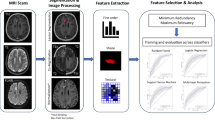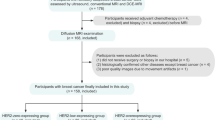Abstract
Objectives
To evaluate the feasibility of high b-value diffusion-weighted imaging (DWI) for distinguishing non-muscle-invasive bladder cancer (NMIBC) from muscle-invasive bladder cancer (MIBC) and low- from high-grade bladder urothelial carcinoma using a fractional-order calculus (FROC) model as well as a combination of FROC DWI and bi-parametric Vesical Imaging-Reporting and Data System (VI-RADS).
Methods
Fifty-eight participants with bladder urothelial carcinoma were included in this IRB-approved prospective study. Diffusion-weighted images, acquired with 16 b-values (0–3600 s/mm2), were analyzed using the FROC model. Three FROC parameters, D, β, and μ, were used for delineating NMIBC from MIBC and for tumor grading. A receiver operating characteristic (ROC) analysis was performed based on the individual FROC parameters and their combinations, followed by comparisons with apparent diffusion coefficient (ADC) and bi-parametric VI-RADS based on T2-weighted images and DWI.
Results
D and μ were significantly lower in the MIBC group than in the NMIBC group (p = 0.001 for each), and D, β, and μ all exhibited significantly lower values in the high- than in the low-grade tumors (p ≤ 0.011). The combination of D, β, and μ produced the highest specificity (85%), accuracy (78%), and the area under the ROC curve (AUC, 0.782) for distinguishing NMIBC and MIBC, and the best sensitivity (89%), specificity (86%), accuracy (88%), and AUC (0.892) for tumor grading, all of which outperformed the ADC. The combination of FROC parameters with bi-parametric VI-RADS improved the AUC from 0.859 to 0.931.
Conclusions
High b-value DWI with a FROC model is useful in distinguishing NMIBC from MIBC and grading bladder tumors.
Key Points
• Diffusion parameters derived from a FROC diffusion model may differentiate NMIBC from MIBC and low- from high-grade bladder urothelial carcinomas.
• Under the condition of a moderate sample size, higher AUCs were achieved by the FROC parameters D (0.842) and μ (0.857) than ADC (0.804) for bladder tumor grading with p ≤ 0.046.
• The combination of the three diffusion parameters from the FROC model can improve the specificity over ADC (85% versus 67%, p = 0.031) for distinguishing NMIBC and MIBC and enhance the performance of bi-parametric VI-RADS.





Similar content being viewed by others
Abbreviations
- ADC:
-
Apparent diffusion coefficient
- AUC:
-
Area under the curve
- BC:
-
Bladder cancer
- DCE:
-
Dynamic contrast-enhanced
- DWI:
-
Diffusion-weighted imaging
- FOV:
-
Field of view
- FROC:
-
Fractional-order calculus
- FSE:
-
Fast spin-echo
- MIBC:
-
Muscle-invasive bladder cancer
- NMIBC:
-
Non-muscle-invasive bladder cancer
- ROC:
-
Receiver operating characteristic
- TURBT:
-
Transurethral resection of bladder tumor
- VI-RADS:
-
Vesical Imaging Reporting and Data System
References
Bray F, Ferlay J, Soerjomataram I et al (2018) Global cancer statistics 2018: GLOBOCAN estimates of incidence and mortality worldwide for 36 cancers in 185 countries. CA Cancer J Clin 68:394–424
Babjuk M, Burger M, Compérat EM et al (2019) European association of urology guidelines on non-muscle-invasive bladder cancer (TaT1 and carcinoma in situ) - 2019 update. Eur Urol 76:639–657
Alfred Witjes J, Lebret T, Compérat EM et al (2017) Updated 2016 EAU guidelines on muscle-invasive and metastatic bladder cancer. Eur Urol 71:462–475
Herr HW, Donat SM (2008) Quality control in transurethral resection of bladder tumours. BJU Int 102:1242–1246
Ark JT, Keegan KA, Barocas DA et al (2014) Incidence and predictors of understaging in patients with clinical T1 urothelial carcinoma undergoing radical cystectomy. BJU Int 113:894–899
Padhani AR, Liu G, Koh DM et al (2009) Diffusion-weighted magnetic resonance imaging as a cancer biomarker: consensus and recommendations. Neoplasia 11:102–125
Tang L, Zhou XJ (2019) Diffusion MRI of cancer: from low to high b-values. J Magn Reson Imaging 49:23–40
Kobayashi S, Koga F, Kajino K et al (2014) Apparent diffusion coefficient value reflects invasive and proliferative potential of bladder cancer. J Magn Reson Imaging 39:172–178
Kobayashi S, Koga F, Yoshida S et al (2011) Diagnostic performance of diffusion-weighted magnetic resonance imaging in bladder cancer: potential utility of apparent diffusion coefficient values as a biomarker to predict clinical aggressiveness. Eur Radiol 21:2178–2186
Abou-El-Ghar ME, El-Assmy A, Refaie HF, El-Diasty T (2009) Bladder cancer: diagnosis with diffusion-weighted MR imaging in patients with gross hematuria. Radiology 251:415–421
Wang Y, Shen Y, Hu X et al (2020) Application of R2* and apparent diffusion coefficient in estimating tumor grade and T category of bladder cancer. AJR Am J Roentgenol 214:383–389
Panebianco V, Narumi Y, Altun E et al (2018) Multiparametric magnetic resonance imaging for bladder cancer: development of VI-RADS (vesical imaging-reporting and data system). Eur Urol 74:294–306
Pecoraro M, Takeuchi M, Vargas HA et al (2020) Overview of VI-RADS in bladder cancer. AJR Am J Roentgenol 214:1259–1268
Li Z, Li H, Wang S et al (2019) MR-Based radiomics nomogram of cervical cancer in prediction of the lymph-vascular space invasion preoperatively. J Magn Reson Imaging 49:1420–1426
Wang F, Chen HG, Zhang RY et al (2019) Diffusion kurtosis imaging to assess correlations with clinicopathologic factors for bladder cancer: a comparison between the multi-b value method and the tensor method. Eur Radiol 29:4447–4455
Zhou XJ, Gao Q, Abdullah O, Magin RL (2010) Studies of anomalous diffusion in the human brain using fractional order calculus. Magn Reson Med 63:562–569
Sui Y, Xiong Y, Jiang J et al (2016) Differentiation of low- and high-grade gliomas using high b-value diffusion imaging with a non-Gaussian diffusion model. AJNR Am J Neuroradiol 37:1643–1649
Sui Y, Wang H, Liu G et al (2015) Differentiation of low- and high-grade pediatric brain tumors with high b-value diffusion-weighted MR imaging and a fractional order calculus model. Radiology 277:489–496
Karaman MM, Tang L, Li Z, et al (2021) In vivo assessment of Lauren classification for gastric adenocarcinoma using diffusion MRI with a fractional order calculus model. Eur Radiol 31:5659-5668
Tang L, Sui Y, Zhong Z et al (2018) Non-Gaussian diffusion imaging with a fractional order calculus model to predict response of gastrointestinal stromal tumor to second-line sunitinib therapy. Magn Reson Med 79:1399–1406
Pizzi AD, Mastrodicasa D, Marchioni M et al (2021) Bladder cancer: do we need contrast injection for MRI assessment of muscle invasion? A prospective multi-reader VI-RADS approach. Eur Radiol 31:3874–3883
Dice LR (1945) Measures of the amount of ecologic association between species. Ecology 26:297–302
Menard S (2002) Applied logistic regression analysis. Sage, Thousand Oaks California
Perkins NJ, Schisterman EF (2006) The inconsistency of “optimal” cutpoints obtained using two criteria based on the receiver operating characteristic curve. Am J Epidemiol 163:670–675
Fagerland MW, Lydersen S, Laake P (2013) The McNemar test for binary matched-pairs data: mid-p and asymptotic are better than exact conditional. BMC Med Res Methodol 13:91
Hanley JA, McNeil BJ (1983) A method of comparing the areas under receiver operating characteristic curves derived from the same cases. Radiology 148:839–843
Union for International Cancer Control (2017) TNM classification of malignant tumours, 8th edn. Wiley-Blackwell, Hoboken
Humphrey PA, Moch H, Cubilla AL et al (2016) The 2016 WHO classification of tumours of the urinary system and male genital organs—part B: prostate and bladder tumours. Eur Urol 70:106–119
Liu Y, Zhang Y, Cheng R et al (2019) Radiomics analysis of apparent diffusion coefficient in cervical cancer: a preliminary study on histological grade evaluation. J Magn Reson Imaging 49:280–290
Wang Y, Hu D, Yu H et al (2019) Comparison of the diagnostic value of monoexponential, biexponential, and stretched exponential diffusion-weighted MRI in differentiating tumor stage and histological grade of bladder cancer. Acad Radiol 26:239–246
Magin RL, Akpa BS, Neuberger T, Webb AG (2011) Fractional order analysis of Sephadex gel structures: NMR measurements reflecting anomalous diffusion. Commun Nonlinear Sci Numer Simul 16:4581–4587
Magin RL, Abdullah O, Baleanu D, Zhou XJ (2008) Anomalous diffusion expressed through fractional order differential operators in the Bloch-Torrey equation. J Magn Reson 190:255–270
O’Brien T, Cranston D, Fuggle S et al (1995) Different angiogenic pathways characterize superficial and invasive bladder cancer. Cancer Res 55:510–513
Karaman MM, Wang H, Sui Y et al (2016) A fractional motion diffusion model for grading pediatric brain tumors. Neuroimage Clin 12:707–714
Karaman MM, Sui Y, Wang H et al (2016) Differentiating low- and high-grade pediatric brain tumors using a continuous-time random-walk diffusion model at high b-values. Magn Reson Med 76:1149–1157
Karaman MM, Zhang J, Zhu W et al (2021) Quartile histogram assessment of glioma malignancy using high b-value diffusion MRI with a continuous-time random-walk model. NMR Biomed 34:e4485
Suo S, Chen X, Ji X et al (2015) Investigation of the non-gaussian water diffusion properties in bladder cancer using diffusion kurtosis imaging: a preliminary study. J Comput Assist Tomogr 39:281–285
Wang H, Luo C, Zhang F et al (2019) Multiparametric MRI for bladder cancer: validation of VI-RADS for the detection of detrusor muscle invasion. Radiology 291:668–674
Acknowledgements
The authors would like to thank Dr. Qingfei Luo, Dr. Kaibao Sun, Dr. Kezhou Wang, and Dr. Rahul Mehta of the University of Illinois at Chicago for helpful discussions.
Funding
The authors state that this work has not received any funding.
Author information
Authors and Affiliations
Corresponding authors
Ethics declarations
Guarantor
The scientific guarantor of this publication is Cui Feng.
Conflict of interest
The authors of this manuscript declare no relationships with any companies whose products or services may be related to the subject matter of the article.
Statistics and biometry
One of the authors (M. Muge Karaman) has significant statistical expertise.
Informed consent
Written informed consent was obtained from all participants in this study.
Ethical approval
Institutional Review Board approval was obtained.
Methodology
• Prospective
• Diagnostic or prognostic study
• Performed at one institution
Additional information
Publisher’s note
Springer Nature remains neutral with regard to jurisdictional claims in published maps and institutional affiliations.
Rights and permissions
About this article
Cite this article
Feng, C., Wang, Y., Dan, G. et al. Evaluation of a fractional-order calculus diffusion model and bi-parametric VI-RADS for staging and grading bladder urothelial carcinoma. Eur Radiol 32, 890–900 (2022). https://doi.org/10.1007/s00330-021-08203-2
Received:
Revised:
Accepted:
Published:
Issue Date:
DOI: https://doi.org/10.1007/s00330-021-08203-2




